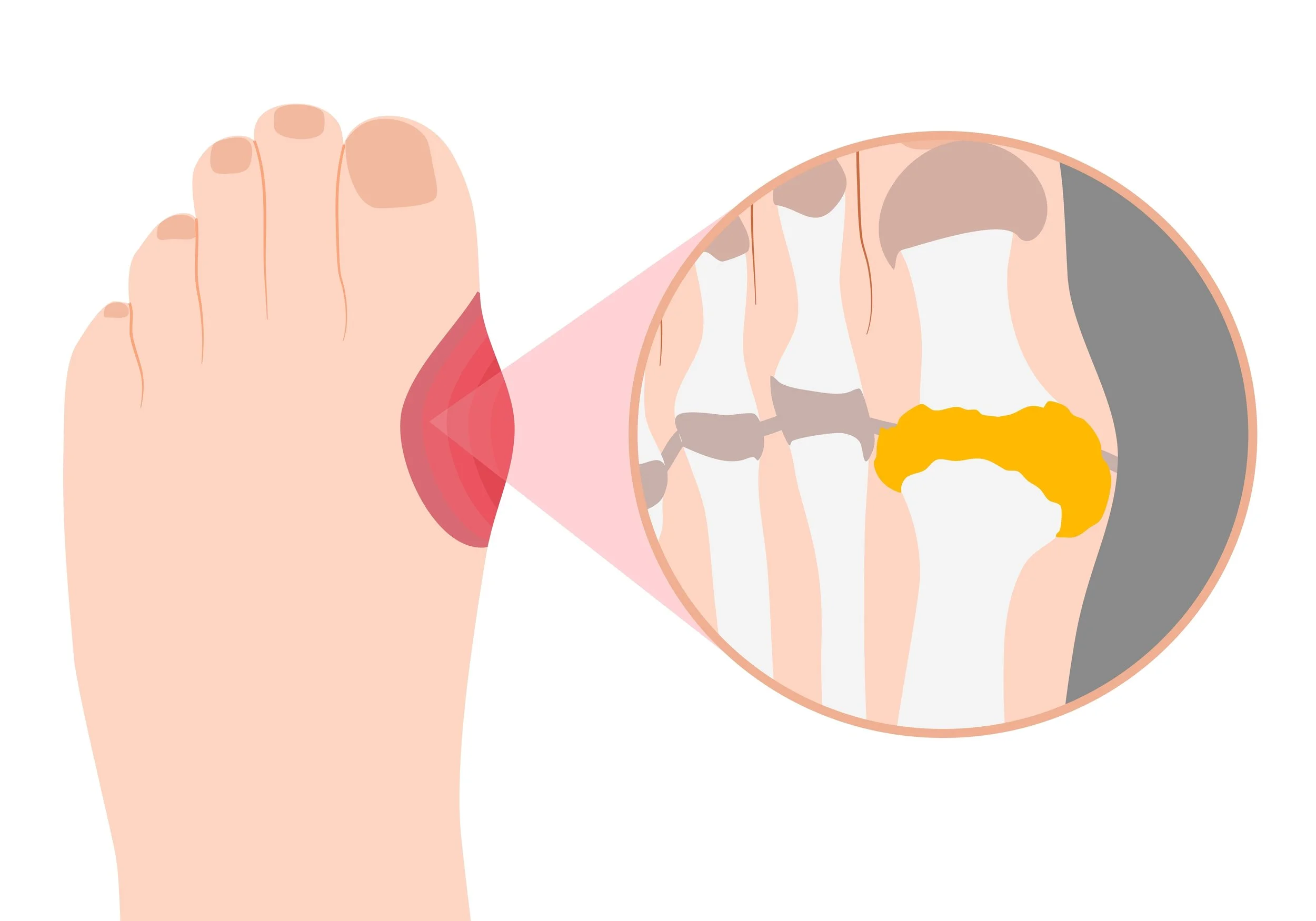Gout in the Feet: What it Is, How it Shows Up, and How Podiatrists Treat it
What do you get when you supercharge arthritis and make it meaner? The answer is gout.
Gout is like the person in charge of handing out disease symptoms thought regular arthritis could use some extra juice.
Sounds fun, right?
If you’re one of the many people who contend with gout in your feet, you’re well aware of the intense pain, stiffness, and swelling a flare-up delivers. It can really ruin your day.
Ready for some good news?
Gout is very treatable and even preventable when you have the knowledge and know-how to stay ahead of it.
At City Step Podiatry, we’re focused on helping our valued patients step strong and stay pain-free—so they can fully enjoy the many wonders of this beautiful city we call home.
Because we’re always listening, we noticed when the subject of gout popped up several times recently. That’s why we decided to frontload it as our next informative blog topic.
Read on to discover everything you need to know about gout in the feet.
From its common symptoms to who’s most at risk, and from how you can prevent and manage it yourself to how your friendly neighborhood podiatrist can help—we’ll help you learn how to bid goodbye to gout for good!
What is gout, and why does it affect the feet?
Like we said above—gout is basically arthritis with an attitude.
To put it a bit more clinically, gout is a complex type of inflammatory arthritis that causes intense joint pain and swelling when it strikes.
Other symptoms of gout include:
Joint stiffness and limited range of motion
Extreme tenderness of the affected area
Redness
Discoloration
Radiating warmth at the impacted joint
Gout is a common condition and the most common form of inflammatory arthritis. It affects almost 4% of Americans, which adds up to just under 10 million people in this country alone.
While gout can impact anyone, it’s more common in certain people.
Those at increased risk for developing gout include:
Men
Older adults (especially those over 65)
Post menopausal women
Those who are overweight or obese
Those with a family history of gout
Those who take immunosuppressants
Those who eat a lot of meat, especially red meat, shellfish, and organ meat
Gout also often co-occurs with other medical conditions and health issues. These include:
Chronic kidney disease (CKD)
Congestive heart failure (CHF)
Diabetes
High blood pressure (hypertension)
Blood cancer
In some cases, gout attacks can be brought on by surgery or trauma.
What causes gout in the feet?
Gout can affect many body parts, including the hands and wrists, knees, ankles, and elbows.
To understand what gout is and how it happens, we need to dive into some science. Ready?
Whenever you eat, your body goes to work breaking it down and distributing the necessary vitamins, minerals, nutrients, and waste from what you eat to your various systems.
Part of this process involves breaking down organic compounds called purines. Purines are found in many different foods, but high levels are present in red meat and organ meats (like liver), and seafood.
When your body breaks purines down, it creates uric acid as a waste product.
Uric acid is a chemical compound that’s one of your body’s normal waste products. Typically, it’s quickly dissolved in your blood, shuttled to your kidneys, and removed as waste through your urine. Easy peasy.
But, sometimes, your body doesn't manage uric acid effectively, or it finds itself with too much to handle. This causes uric acid to accumulate in your body without being processed and excreted.
When this happens, the built-up uric acid starts to form into crystals. These sharp, needle-like formations love to congregate in your joints and their surrounding tissue.
The accumulation of these sharp urate crystals causes the pain, inflammation, and swelling known as gout.
But why does gout affect the feet so often?
For a few good reasons—
Not only do your feet contain many joints and connective tissue, they also occupy the lowest point of your body. This position makes them extremely susceptible to the buildup of urate crystals through the work of good-old gravity.
Their position as an extremity also means their average temperature is lower than that of other parts of your body. Uric crystals more easily form in lower temps.
Related fact—this is also why gout symptoms often pop up first in your big toe, which has the lowest temp of all your five little piggies.
Finally, your feet get a high level of impact, which can also encourage uric acid to accumulate.
Now that you know what gout is and why it happens, let’s dive into gout prevention and treatment.
Gout prevention and treatment
Thankfully, there are lots of ways to keep gout at bay and treat it when it crops up.
The foods and drinks you choose have a major effect on gout symptoms. With awareness and savvy choices, you can modify your diet to reduce your risk of a gout attack.
Foods and beverages known to contribute to uric acid buildup and gout include:
Red meats (including beef, pork, and lamb)
Organ meat (like liver and kidney)
Seafood (especially options like tuna, shellfish, scallops, trout, haddock, and herring)
Turkey (particularly the deli-sliced kind)
Gravies
Meat-based sauces
Alcohol
Sodas, juices, and other sugary drinks
Sweets and candies (especially those containing high fructose corn syrup)
Moderating these items in your daily intake can help reduce your risk for a gout flare-up by controlling the levels of uric acid in your body to manageable amounts.
Diagnosing gout in the feet
To prevent and treat gout in the feet, the first step is getting a proper diagnosis.
Your podiatrist or PCP typically diagnoses gout with a combination of a physical exam, symptom assessment, and diagnostic tests.
Your clinical assessment may involve imaging tests like X-rays, MRIs, CT scans, and ultrasounds. It may also include blood testing and joint aspiration. This procedure involves extracting and assessing a fluid sample from an affected joint using a needle.
Once your gout is differentially diagnosed by a professional, you can move on to management and treatment.
Gout treatment
Your doctor will likely counsel you to start by reducing or eliminating high-purine foods and drinks (like the ones mentioned above) from your diet.
Managing gout symptoms and keeping flare-ups at bay is all about wisely choosing what fuel you give your body. As with anything, it’s all about balance. Finding yours will help you keep your gout symptoms under control.
Your doctor may recommend that you follow a low-purine diet to keep your gout symptoms and risks at bay.
In addition to focusing on symptom management with diet and lifestyle modifications, gout treatment and prevention may also involve medications.
Your podiatrist may prescribe different gout medications to target two specific issues:
1. Pain and inflammation management
2. Uric acid production and elimination to reduce risks for gout complications.
Medicines used to treat gout inflammation and pain include anti-inflammatories like Advil, Motrin, Aleve, as well as more potent prescription NSAIDs (if necessary), and corticosteroids.
Medicines used to target uric acid include those that limit the amount of uric acid your body creates (such as Aloprim, Lopurin, Zyloprim, and Uloric) and those that support your kidneys’ ability to process and eliminate uric acid (such as Probalan).
When it comes to her approach to gout treatment, Dr. Young typically starts with an oral steroid pack for rapid symptom relief. She then closely monitors you if it’s your first experience with a flare.
If you’re a recurrent gout sufferer, Dr. Young will also obtain uric acid labs to assess your needs for preventative treatments.
Your gout treatment options from City Step Podiatry will be tailored to your unique health goals and needs.
Dr. Young will work with you to select and plan a personalized treatment course that aligns with your lifestyle and care needs.
Although there may not be a cure for gout, you can effectively manage its symptoms and prevent future flare-ups with the right support, approach, and knowledge.
At City Step Podiatry, we take pride in providing each patient with the personalized care and consideration they deserve.
We’ll collaborate to help you achieve your best results for any foot or ankle issue you’re facing. With cutting-edge treatments, flexibility in scheduling and payment options, and expertise, we’re committed to keeping Chicago active and thriving.
When gout strikes, we’re here to support you and help you find the solutions you need.
With our convenient downtown Chicago office location, flexible scheduling, and array of state-of-the-art treatments and services—City Step Podiatry is uniquely able to serve the podiatry needs of active Chicagoans like you. Book with us easily online and visit our blog regularly for insight and guidance to keep you stepping strong.
City Step Podiatry is here for you! Reach out today to schedule your visit and treat your feet to the care they deserve.









